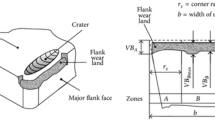Abstract
Tool wear has been extensively studied in the past due to its effect on the surface quality of the finished product. Vision-based systems using a CCD camera are increasingly being used for measurement of tool wear due to their numerous advantages compared to indirect methods. Most research into tool wear monitoring using vision systems focusses on off-line measurement of wear. The effect of wear on surface roughness of the workpiece is also studied by measuring the roughness off-line using mechanical stylus methods. In this work, a vision system using a CCD camera and backlight was developed to measure the surface roughness of the turned part without removing it from the machine in-between cutting processes, i.e. in-cycle. An algorithm developed in previous work was used to automatically correct tool misalignment using the images and measure the nose wear area. The surface roughness of turned parts measured using the machine vision system was verified using the mechanical stylus method. The nose wear was measured for different feed rates and its effect on the surface roughness of the turned part was studied. The results showed that surface roughness initially decreased as the machining time of the tool increased due to increasing nose wear and then increased when notch wear occurred.
Similar content being viewed by others
References
Kurada S, Bradley C (1997) A review of machine vision sensors for tool condition monitoring. Comput Ind 34:55–72
Kassim AA, Mian Z, Mannan MA (2004) Connectivity oriented fast Hough transform for tool wear monitoring. Pattern Recogn 37:1925–1933
Choudhury SK, Bartarya G (2003) Role of temperature and surface finish in predicting tool wear using neural network and design of experiments. Int J Mach Tools Manuf 43:747–753
Sortino M (2003) Application of statistical filtering for optical detection of tool wear. Int J Mach Tools Manuf 43:493–497
Pfeifer T, Wiegers L (2000) Reliable tool wear monitoring by optimized image and illumination control in machine vision. Measurement 28:209–218
Lanzetta M (2001) A new flexible high-resolution vision sensor for tool condition monitoring. J Mater Process Technol 119:73–82
Yang MY, Kwon OD (1996) Crater wear measurement using computer vision and automatic focusing. J Mater Process Technol 58:362–367
Wang WH, Hong GS, Wong YS (2006) Flank wear measurement by a threshold independent method with sub-pixel accuracy. Int J Mach Tool Manu 46(2):199–207
Kurada S, Bradley C (1997) A machine vision system for tool wear assessment. Tribology Int 30(4):294–304
Jurkovic J, Korosec M, Kopac J (2005) New approach in tool wear measuring technique using CCD vision system. Int J Mach Tools Manu 45:1023–1030
Dawson TG, Kurfess TR (2005) Quantification of tool wear using white light interferometry and three-dimensional computational metrology. Int J Mach Tool Manu 45:591–596
Mannan MA, Kassim AA, Jing M (2000) Application of image and sound analysis techniques to monitor the condition of cutting tools. Pattern Recogn Lett 21:969–979
Pavel R, Marinescu J, Deis M, Pillar J (2005) Effect of tool wear on surface finish for a case of continuous and interrupted hard turning. J Mater Process Technol 170:341–349
Tamizharasan T, Selvaraj T, Noorul Haq A (2006) Analysis of tool wear and surface finish in hard turning. Int J Adv Manuf Technol 28:671–679
Shahabi HH, Ratnam MM (2007) On-line monitoring of tool wear in turning operation in the presence of tool misalignment. Int J Adv Manuf Tech. DOI 10.1007/s00170-007-1119-4
Gonzalez RC, Woods RE, Eddins SL (2004) Digital image processing using Matlab. Pearson-Prentice Hall, New Jersey
Lim JS (1990) Two-dimensional signal and image processing. Prentice Hall, Englewood Cliffs, NJ, pp 536–540
Otsu N (1979) A threshold selection method from gray-level histograms. IEEE Trans Syst Man Cybern 9(1):62–66
Gayler JFW, Shotbolt CR (1990) Metrology for engineers. Cassell, London
Kwon Y, Fischer GW (2003) A novel approach to quantifying tool wear and tool life measurements for optimal tool management. Int J Mach Tool Manu 43:359–368
Author information
Authors and Affiliations
Corresponding author
Rights and permissions
About this article
Cite this article
Shahabi, H.H., Ratnam, M.M. In-cycle monitoring of tool nose wear and surface roughness of turned parts using machine vision. Int J Adv Manuf Technol 40, 1148–1157 (2009). https://doi.org/10.1007/s00170-008-1430-8
Received:
Accepted:
Published:
Issue Date:
DOI: https://doi.org/10.1007/s00170-008-1430-8




